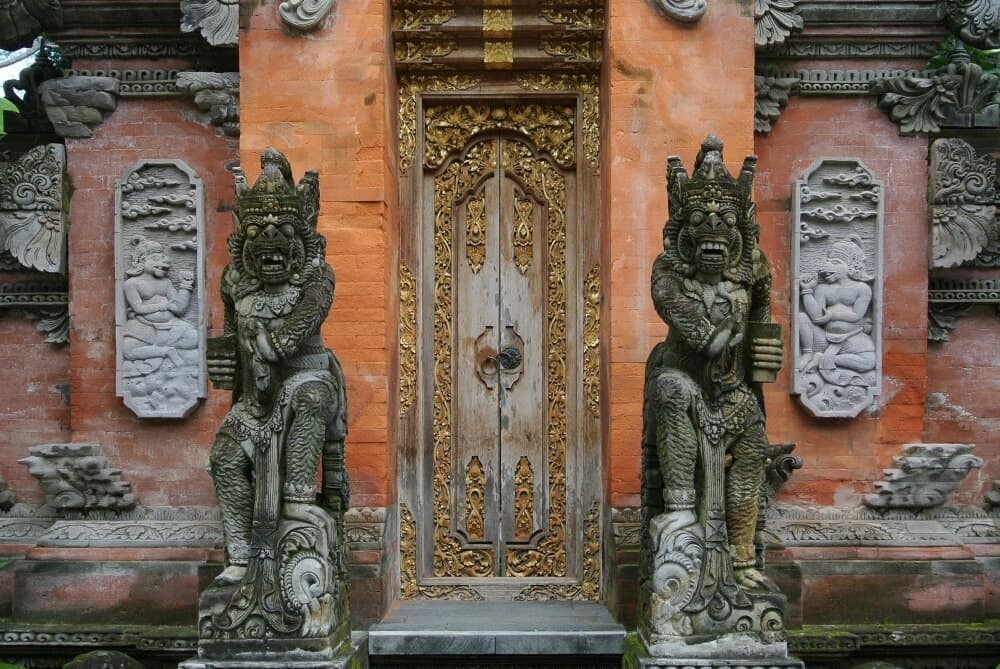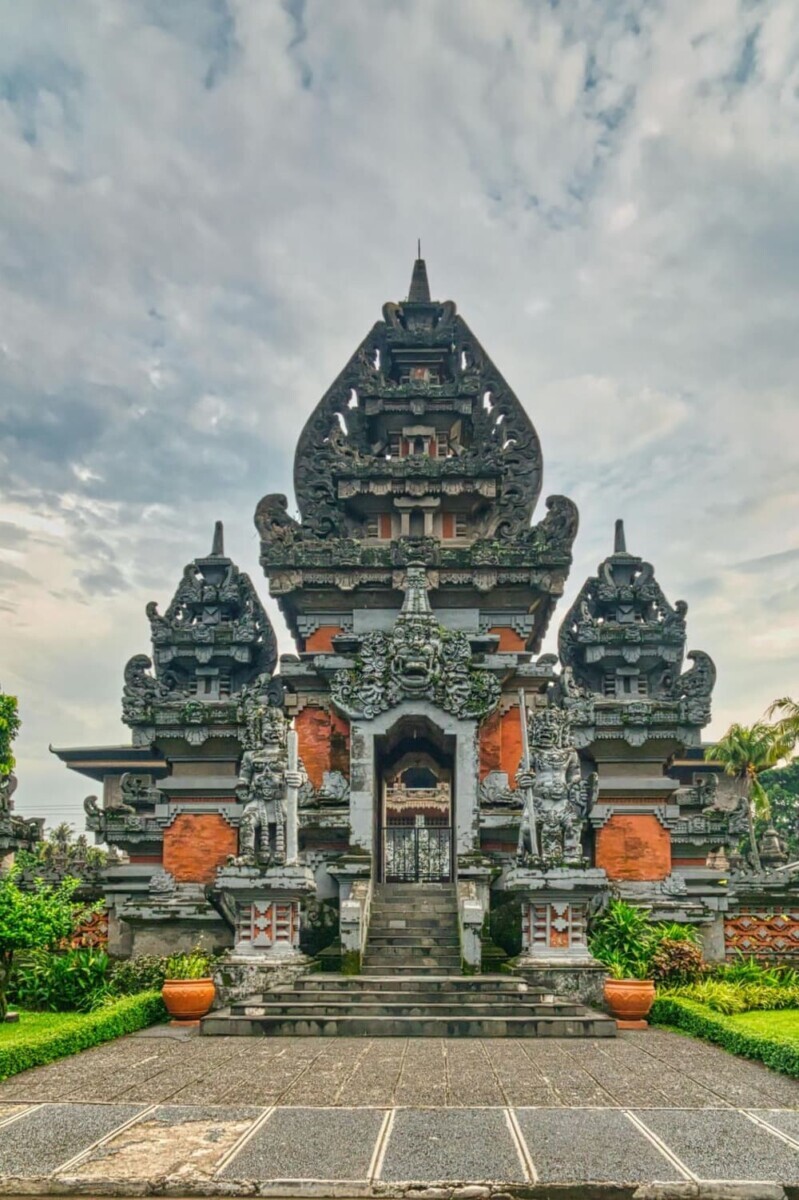Bali is an island located in Indonesia, known for its natural beauty, rich culture, and vibrant spiritual life. Called the “Island of the Gods,” it attracts millions of tourists annually.
The geography of Bali is diverse, with white sandy beaches in the south, rocky coasts and coral reefs in the east, and green hills and volcanoes in the north and west.
Balinese culture is a unique fusion of Hinduism, art, and ancestral traditions. The temples, known locally as “pura,” are scattered throughout the island. Each temple has a particular significance and serves specific functions within the Balinese Hindu community and religion.
Therefore, today we are telling you a bit more about them, in case you choose Bali as your destination for your volunteer experience.

Temples are the heart of religious life in Bali. They serve as places of worship, rituals, and ceremonies, and also as community centers where festivals and cultural events are celebrated.
The architecture of Balinese temples is rich in symbolism. Their design includes elements such as monumental gates (candi bentar), altars, and shrines that represent different deities and spirits. The decorations often include detailed carvings and symbolic ornaments.
There are different types of temples:
- Pura Desa: Village temples, dedicated to the protection of the local community.
- Pura Puseh: Temples dedicated to the founding ancestors of the village.
- Pura Dalem: Temples of the dead and of death, where funerary rituals are performed.
- Pura Besakih: The mother temple, is the most important and sacred temple in Bali, located on Mount Agung.
The numerous rituals and festivities celebrated in these temples mark the Balinese calendar. Celebrations such as Galungan, Kuningan, and Nyepi (the day of silence) are crucial in religious life.
Temples are often built in places with particular spiritual significance, such as mountains, lakes, and caves. This reinforces the connection of the Balinese with nature and their belief in the harmony between humans and the natural environment. Each temple is maintained and managed by the local community. Families have specific responsibilities for the care of the temple and the preparation of offerings and ceremonies.
There are many famous temples, each with its own history, importance, and beauty.
PURA BESAKIH
As we mentioned earlier, this temple is known as the “Mother Temple” of Bali. Pura Besakih is the largest and most sacred temple complex on the island, located on the slopes of Mount Agung. It is a center of pilgrimage and ceremonies for the Balinese.
The complex consists of 23 temples and is designed in terraces ascending the mountain, with the largest and most significant being Pura Pentaran Agung, notable for its impressive entrance gate, multiple levels, and numerous shrines dedicated to various Hindu deities. In addition to Pura Penataran Agung, other prominent temples in the complex include Pura Batu Madeg and Pura Kiduling Kreteg, each with its own significance and specific deities.
Pura Besakih has been a place of worship for over a thousand years, with historical references dating back to the 8th century. Its location on the slopes of an active volcano adds a mystical aura, and the Balinese believe that this site is protected by the gods.
The temple is the scene of numerous ceremonies and festivals throughout the year, with the most important being the “Odalan,” celebrated in each temple on a 210-day cycle of the Balinese Pawukon calendar. During these events, the complex is filled with devotees dressed in their best traditional attire, offering prayers, flowers, and food to the gods.
Apart from its religious importance, Pura Besakih is also a popular tourist destination, attracting visitors from all over the world who come to admire its architecture, history, and the stunning views of the surrounding landscape. Its location on the slopes of the volcano adds a mystical aura, which is why the Balinese believe that this site is protected by the gods.

PURA TANAH LOT
Situated on a rock in the sea, this temple is one of the most iconic and photographed in Bali. It is famous for its stunning sunsets and unique location, making it a spectacular site.
It was founded in the 16th century by the priest Dang Hyang Nirartha. According to legend, Nirartha arrived in Bali to spread Hindu teachings and found this site particularly sacred. It is said that he convinced the local fishermen to build a temple on the islet to honor the sea gods.
During high tide, it appears to float in the ocean. During low tide, it is possible to walk to the base of the temple.
It is one of seven sea temples that form a chain along the Balinese coast, each of which is positioned in such a way that the next temple in the chain can be seen. These temples protect the island from evil sea spirits. Pura Tanah Lot is especially important to the Balinese who worship Baruna, the sea god.
It is an important pilgrimage site, with several ceremonies held throughout the year, the most notable being the Odalan festival, which celebrates the dedication of the temple.
Due to sea erosion, Pura Tanah Lot has undergone several conservation projects. In the 1980s and 1990s, major efforts were made to stabilize the rock on which the temple stands and to ensure its preservation for future generations.
PURA ULUN DANU BRATAN
This temple, dedicated to the water goddess Dewi Danu, is located on the shores of Lake Bratan in the mountains of Bedugul. Its image reflected in the water creates a picturesque view popular among visitors.
The temple was built in 1633 by King Mengwi, and its name “Ulun Danu” means “at the shores of the lake” in Balinese. It plays a crucial role in Balinese agriculture, as Lake Bratan is an important source of water for the region’s subak irrigation system.
It is composed of several shrines and merus (multi-tiered towers) built on small islets and surrounded by Lake Bratan. The location of the temple, surrounded by tranquil waters and with mountains as a backdrop, creates a serene and magical image, especially in the morning when mist often envelops the area.
Notable buildings include Pura Teratai Bang, dedicated to Brahma-Vishnu-Shiva, and Pura Dalem Purwa, dedicated to the goddess Dewi Danu and fertility.
It is a place of pilgrimage and celebration during various Balinese festivals. The most notable is the Piodalan ceremony, held every 210 days, coinciding with the Balinese Pawukon calendar.
PURA LUHUR ULUWATU
Located on a cliff 70 meters above the Indian Ocean, this temple is known for both its impressive location and the Kecak dances performed at sunset. It is one of the most important temples for protecting Bali from evil sea spirits. At the southern tip of Bali, this Hindu temple is known for its spiritual significance and panoramic views of the Indian Ocean.
The temple dates back to the 11th century and is attributed to Mpu Kuturan, a Javanese priest who significantly contributed to Balinese religious architecture. Pura Luhur Uluwatu is dedicated to the sea spirits and is one of the temples believed to protect the island from evil spirits. “Luhur” means “something of divine origin” and “Uluwatu” means “rock tip.”
There is a path that winds along the cliff’s edge, offering impressive panoramic views and an opportunity to observe the natural beauty of the place.
It is an important place of worship for the Balinese, who come here to perform ceremonies and offerings to the sea gods. The temple is especially revered during the Kuningan and Galungan ceremonies when the Balinese celebrate the victory of good over evil and honor the spirits of their ancestors.
One of the temple’s most outstanding attractions is the traditional Balinese Kecak dance, performed at sunset in an open-air amphitheater near the temple. The Kecak dance, accompanied by the stunning backdrop of the sun setting over the ocean, is an unforgettable experience.
PURA TAMAN AYUN
Located in Mengwi, this temple is known for its beautiful gardens and architecture. It is a perfect example of the beauty of Bali’s royal temples, surrounded by a moat that gives it a majestic appearance.
It was built in 1634 by the king of Mengwi, I Gusti Agung Putu. “Taman Ayun” means “beautiful garden” in Balinese, reflecting the king’s intention to create a place of tranquility and beauty. The temple served as the family temple of the Mengwi Kingdom and is a notable example of classical Balinese architecture.
It is surrounded by a moat that gives the impression that the temple floats on water. The main entrance leads to a large courtyard divided into three ascending levels, symbolizing the three cosmological levels of the Balinese world: the lower world (bhur), the human world (bwah), and the upper world (swah).
The temple complex is decorated with shrines, pavilions, and merus (multi-tiered towers), some of which reach up to eleven levels, representing the spiritual hierarchy. The surrounding gardens are well-maintained and filled with flowers, fish ponds, and sculptures, adding to the beauty of the place.
It is an active place of worship with several ceremonies held throughout the year, especially during the Odalan festival.
Other well-known temples include Pura Goa Gajah, known as the “Elephant Cave,” Pura Tirta Empul, famous for its sacred springs, Pura Lempuyang Luhur, known for its “Gate of Heaven,” and many more.
If you come to Bali, it is essential to visit some of them and let yourself be enchanted by their landscapes, colors, and structures.




